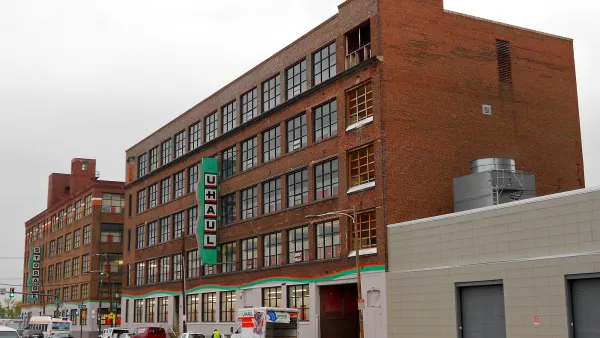While protected bike lanes have yet to be recognized by AASHTO, they are en route to being recognized by US DOT, writes Green Lane Project's Michael Andersen. With federal guidance, transportation engineers may be more willing to build cycle tracks.
With federal recognition that lanes protected from traffic are safer than lanes only separated by a narrow, white line, will the American Association of State Highway and Transportation Officials (AASHTO) follow suit? As noted here last year, the National Association of City Transportation Officials' (NACTO) Urban Bikeway Design Guide was the first to provide engineering guidance for protected bike lanes, also called cycle tracks.
Anderson writes that in "a task order proposal request quietly circulated to selected contractors last week, the (Federal Highway Administration or FHWA) that oversees U.S. road design did exactly what many biking advocates have been urging it to do for years: It suggested that physically separated bikeways can be welcome improvements to American streets and kicked off a process intended to prove it."
"There is a growing body of research on cycle tracks in the U.S. and Canada indicating that, when they are designed well, they do not increase bike crash rates," the agency's document reads. "There is also growing evidence that cyclists prefer cycle tracks."
Speaking of Canada, Streetsblog's Angie Schmitt writes on August 07 that a "study published in the Journal of Transport and Land Use [PDF] found that intersections in Montreal with protected bike lanes see 61 percent more bike traffic than those without."
Safety is the key element that increases cycling numbers among the greater population. Protected bike lanes attract those who are less willing to bike for fear of being hit by motor vehicles, as this August 07 Seattle Times "Editorial: Seattle is playing catch-up on bike safety", illustrates:
Three of those (bike-car collisions) occurred on Dexter Avenue, sending two cyclists to the hospital. Dexter is a designated, high-traffic bike route, but the collisions show that painted bike lanes are doing an inadequate job of separating drivers and cyclists.
Anderson writes about the first steps FHWA is taking to giving "a federal stamp of approval for a [sic] cycle tracks", in the words of John Cameron, chief engineer for the City of Memphis, one of six cities that the Bikes Belong Foundation selected to "Fast Track Protected Bike Lanes".
As ordered by the FHWA, the forthcoming study will look at crash rates and types at 10 to 20 locations that currently offer physically separated cycle tracks, creating a set of recommended design standards and guidelines that FHWA's influence might eventually integrate into the two bibles of U.S. road design: the Manual of Uniform Traffic Control Devices (MUTCD), which discusses traffic signs, signals and markings; and the American Association of State Highway and Transportation Officials road design guide, which discusses the shapes and materials of safe roadways.
FULL STORY: Green Lane Project: At Last! Feds Move Toward A Green Light For Separated Bike Lanes

Analysis: Cybertruck Fatality Rate Far Exceeds That of Ford Pinto
The Tesla Cybertruck was recalled seven times last year.

National Parks Layoffs Will Cause Communities to Lose Billions
Thousands of essential park workers were laid off this week, just before the busy spring break season.

Retro-silient?: America’s First “Eco-burb,” The Woodlands Turns 50
A master-planned community north of Houston offers lessons on green infrastructure and resilient design, but falls short of its founder’s lofty affordability and walkability goals.

Test News Post 1
This is a summary

Analysis: Cybertruck Fatality Rate Far Exceeds That of Ford Pinto
The Tesla Cybertruck was recalled seven times last year.

Test News Headline 46
Test for the image on the front page.
Urban Design for Planners 1: Software Tools
This six-course series explores essential urban design concepts using open source software and equips planners with the tools they need to participate fully in the urban design process.
Planning for Universal Design
Learn the tools for implementing Universal Design in planning regulations.
EMC Planning Group, Inc.
Planetizen
Planetizen
Mpact (formerly Rail~Volution)
Great Falls Development Authority, Inc.
HUDs Office of Policy Development and Research
NYU Wagner Graduate School of Public Service



























